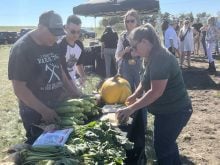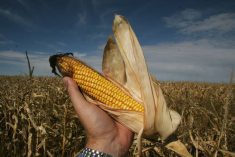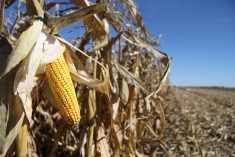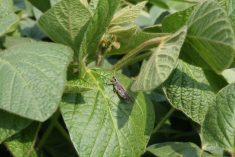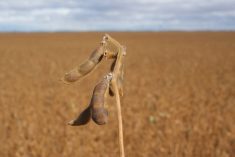Weather also a concern | Cool temperatures in July and August have delayed maturity, and lodging could pose a problem
ZURICH, Ont. — It’s going to take spectacular fall weather to finish Ontario’s grain corn crop.
Sixty percent of the 1.9 million acres that were planted this spring is at risk.
“To me there’s no point of worrying about this, but it’s going to be a worse than 2009,” said Mike Nuttall, a private agronomist in the province.
“I’m concerned about the test weight and I’m concerned about the fill.”
Nuttall, who was speaking at a Farm for Profit field day near Zurich, pointed to Ontario’s seed corn crop as an indicator. Harvest usually begins around Sept. 15, but this year it’s about two weeks behind.
Read Also

Soybean market still figuring out implications of China-U.S. pact
Soybean futures had a muted reaction to the U.S. trade deal with China as the market tries to figure out the nuances of the deal.
Nuttall and other agronomists, including Greg Stewart, a corn specialist with Ontario’s agriculture ministry, said sunshine and warm weather are what’s needed, at least until mid-October.
The 2009 growing season was cooler, but there was an important difference: most of the crop was planted in a timely fashion in April, Stewart said.
This year, thanks to repeated rain delays, more than half the field corn was planted in late May or early June. The situation was further complicated by unusually cool temperatures in July and the first half of August.
“It’s going to be hard for the late-planted corn to put weight on and finish, especially the stuff that decided not to pollinate until the third week of August,” Nuttall said.
The worse case scenario would be a killing frost before the end of September.
Stewart said corn can take a light frost, and leaves can even be burned without completely stopping the plant’s metabolism. However, the plant’s ability to move energy into the cob ends if the stalk temperature drops to -2 C.
Probably the best growers can hope for are above average temperatures and the absence of a killing frost until Thanksgiving.
Even then, it’s unlikely the entire crop will reach the crucial black layer stage, which is full maturity.
“We would consider ourselves absolutely fortunate if we’re able to get most of this crop finished,” Stewart said.
Nuttall said anthracnose stalk rot has also been a problem, which increases the likelihood of lodging. As a result, growers thinking about delaying their harvest until spring to reduce drying costs would be running a huge risk.
Anthracnose can also stop the plant from drying down properly, Nuttall said.
“If all that moisture has to exit through the husk, can you imagine how much sweaty corn, how much mouldy corn, we’ll have?”
He said the western bean cutworm has also been a problem on sandy soils.
The insect usually enters cobs by chewing through the husk near the midpoint of the cob, but this year, it’s being found at the cob tip.
Nuttall said this year’s unusual weather led to corn silk remaining green for an extended period. The pests likely entered the cobs at their tip by devouring the silk, he speculated.



